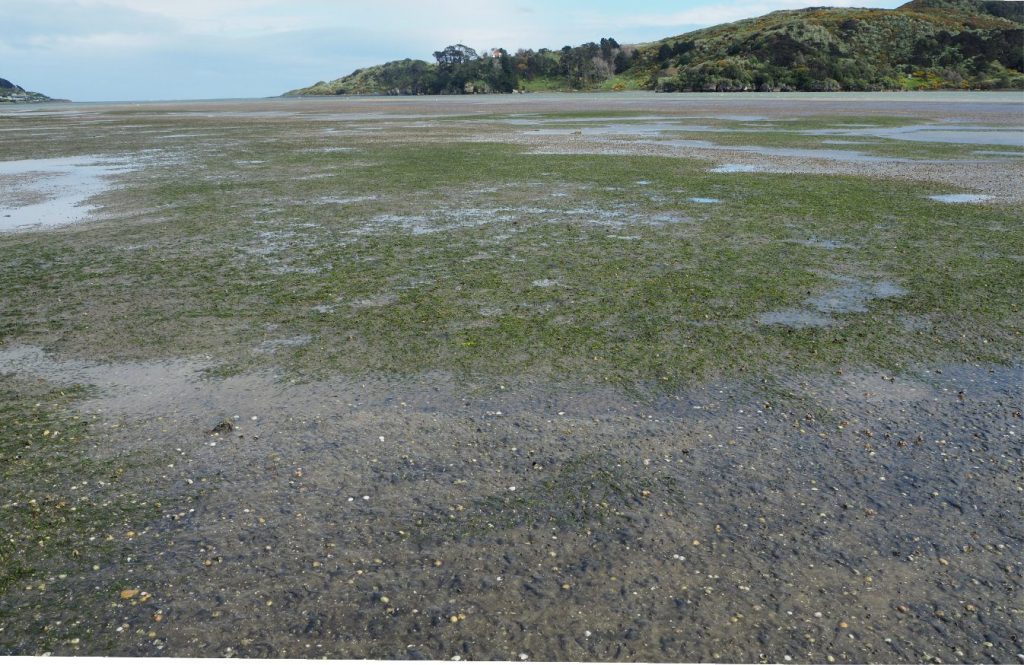
Seagrass meadows are some of the most productive marine ecosystems in the world.
[This is a companion post to Seagrass lithofacies in the rock record]. Four of the images of New Zealand seagrasses were generously donated by Fleur Matheson, NIWA.
I spent much of my childhood wandering the extensive tidal flats and fishing the estuaries of south Waitemata Harbour, the Pacific-fed waterway that embraces east side Auckland, New Zealand. Amongst the many feathered visitors to the tidal flats (between Howick and Beachlands) were huge flocks of black swans that made yearly sojourns to feed on the seagrass meadows. Then, sometime in the late 1960s – early 1970s the seagrass meadows disappeared, along with the swans, the once vibrant and productive ecosystem a victim of widespread pollution and sediment flux across the entire harbour (caused by coastal development, reclamation, storm water runoff, and fertilizer-herbicide runoff). This is a familiar story along many NZ coasts – a microcosm of the global problem of coastal degradation. Coastal seagrasses along with mangrove communities are two of the most productive marine ecosystems in the world – they are also the most threatened.
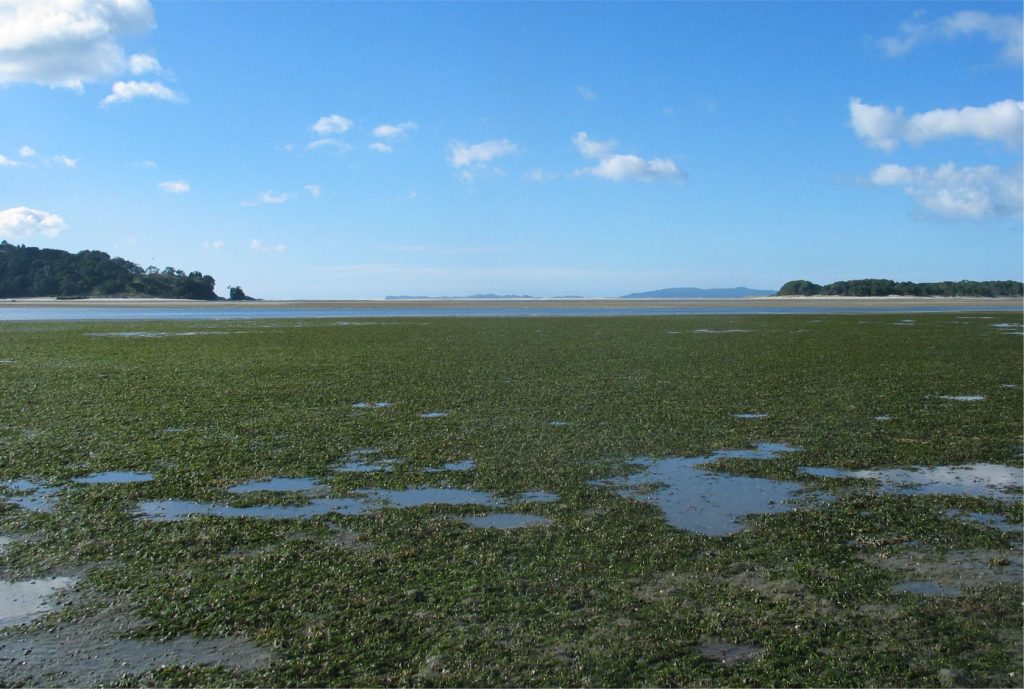
Seagrass communities
Like fields of wheat, submerged seagrass meadows sway with the passing waves and tidal currents. Despite this poetic analogy, the word element ‘grass’ is a misnomer. Seagrasses are monocotyledons, the group of terrestrial angiosperms that develop a single embryonic leaf (dicotyledons develop two embryo leaves). Seagrasses evolved a tolerance to saline conditions from their Late Cretaceous terrestrial ancestors. Like their terrestrial cousins, they develop extensive root systems, produce flowers, and are pollinated while submerged by all the critters that graze, hide, or live within their leafy corridors. Seagrasses are not related to seaweed and other forms of algae – macroalgae are attached by holdfasts rather than roots; algae do not produce flowers. Eelgrass and turtle grass are a couple of common names.
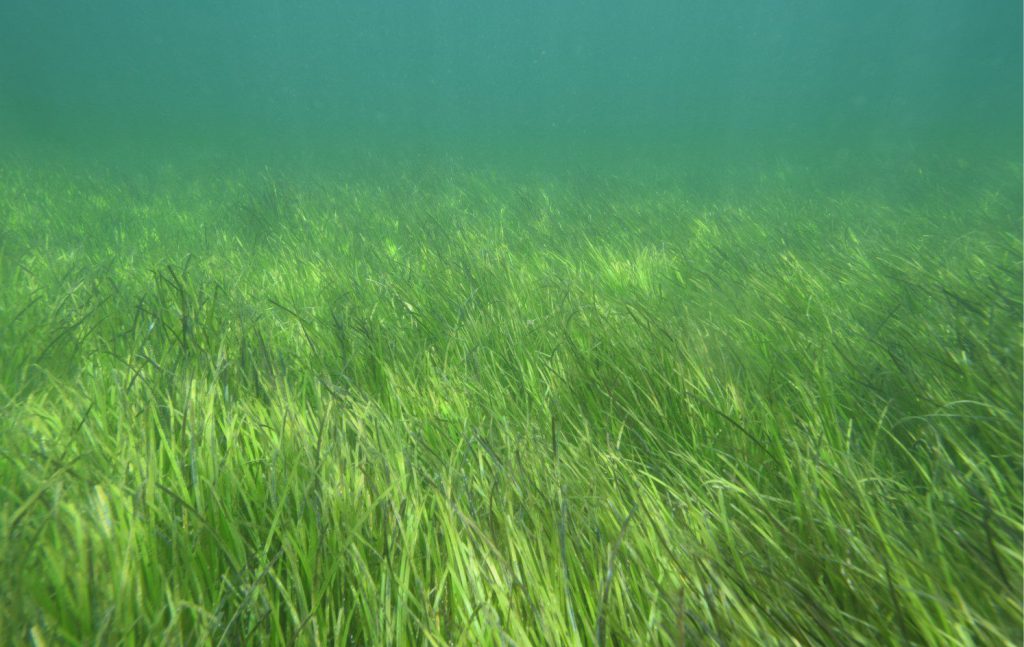
Seagrasses have relatively limited species diversity (60 or 72 species world-wide depending on who you talk to) but they are widely distributed across temperate and tropical coasts. Temperate varieties grow in estuaries, bays, and lagoons, forming extensive meadows between mangroves or salt marshes, and the seaward continuation of tidal and subtidal flats. Tropical varieties also grow in these settings including shallow lagoons behind coral reefs. They tend to avoid coasts that are subjected to high energy wave conditions (e.g., open seas surf zones) where substrates are continually reworked. And like mangrove communities, they help protect coastal areas from strong tidal currents and storm wave attack.
Water depths
Seagrasses thrive in waters shallow and clear enough to permit sufficient light penetration (for photosynthesis). Meadows that develop on tidal flats are subject to diurnal submergence. Some species also thrive in subtidal settings, usually limited to the shallowest few metres of the photic zone but they have been found as deep as 90 m. Frequent periodic or continuous submergence is a prerequisite for their survival. A few genera such as Posidonia are restricted to subtidal conditions, others extend across the range of water depths (e.g., Zostera, Thalassia). They prefer substrates that are not continually reworked by strong currents and energetic waves, which means they usually avoid open coasts with surf zones. They also avoid areas subjected to desiccation.
Physical characteristics
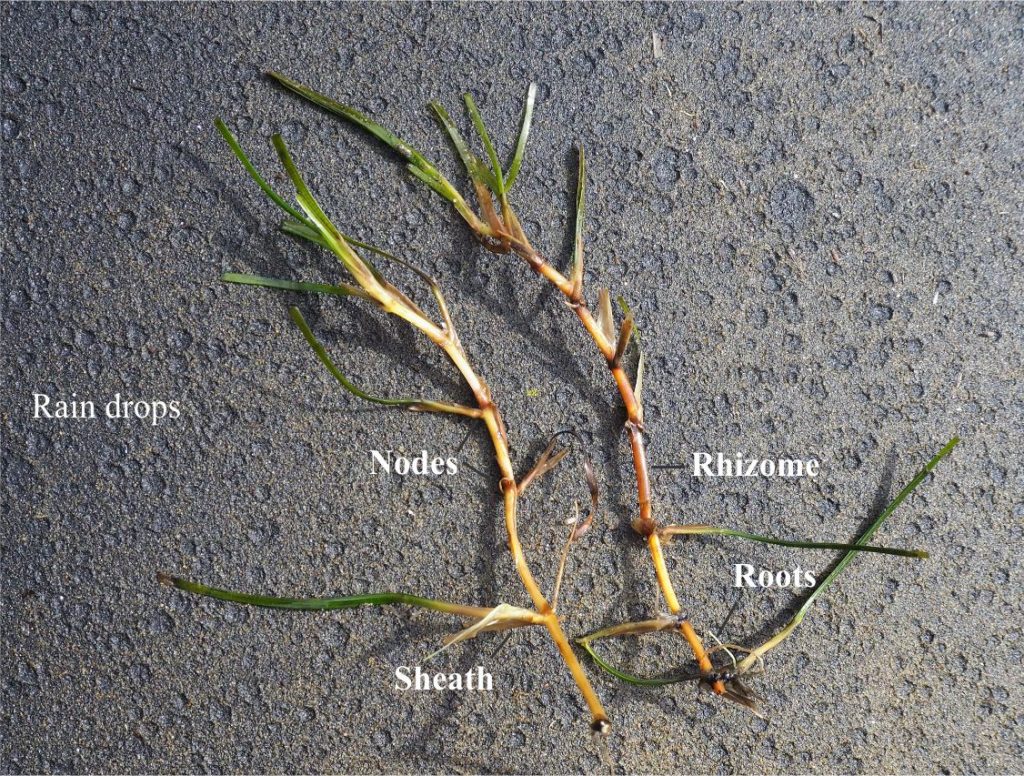
The most common seagrass morphotypes produce long, narrow, flexible leaves with a longitudinal vein. Eel grass and Turtle grass are of this type. Leaves occur singly or in multiples attached to a rhizome via a papery sheaf. Leaf length is variable among species but commonly is 15 cm and more. Leaf margins are smooth. A few smaller species produce more oval-shaped leaves, each attached by a single stem to a rhizome; other small species are compound with multiple leaves arranged in opposite fashion on a single stem (Morrison et al., 2011, PDF).
Rhizomes have a thick, stringy appearance. They are segmented, separated by nodes from which leaf stems and new rhizomes extend. Much finer roots spread from the rhizomes. Rhizomes spread laterally within the substrate – they are only exposed by erosion or predation.
Seagrass substrates
The following characteristics provide context for fossil substrate lithofacies; most of the data is from Piñeiro-Juncal et al., 2022 (PDF available) who review the physical and chemical properties of seagrass soils.
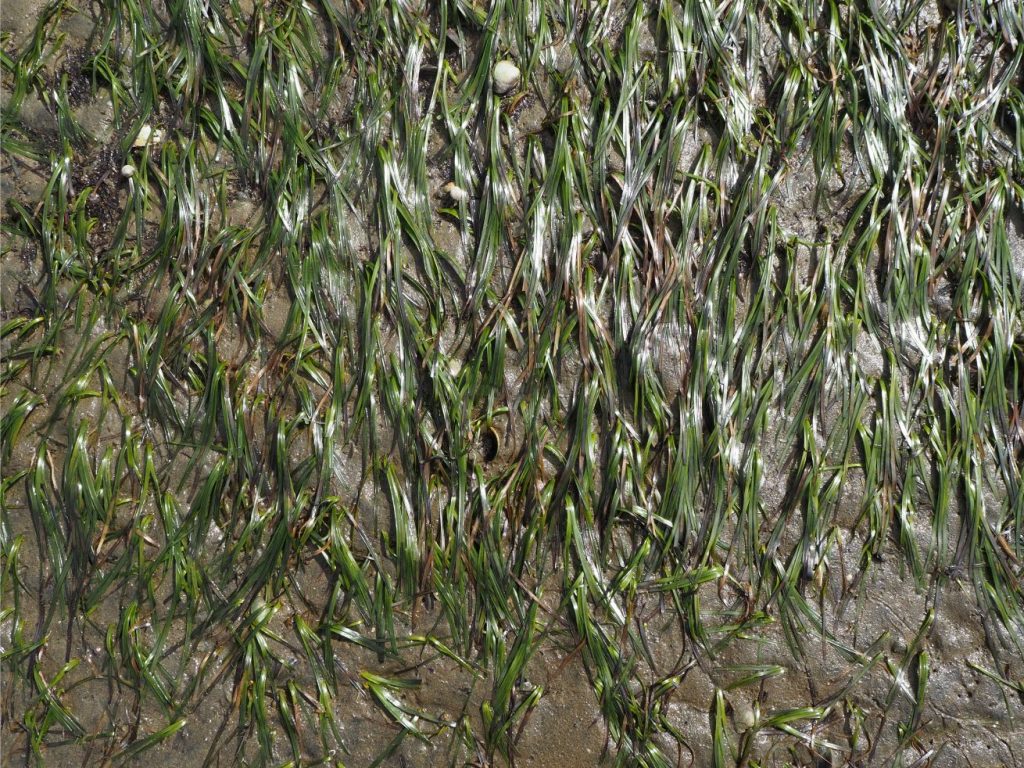
- Seagrass substrates can be classified as marine soils: Although they are not always referred thus in the sedimentological literature, the substrates possess many of the characteristics of their terrestrial soil counterparts – they occur at the sediment-water interface and are subjected to physical, chemical, and biological processes, they are granular, contain organic matter, water, micro- and macrobiota, and gasses (in this case dissolved oxygen and carbon dioxide), and provide the foundation for plant life.
- Composition: Seagrasses grow in siliciclastic, carbonate, and mixed carbonate-siliciclastic sediment that is unconsolidated. Carbonate substrates of the tropical kind will potentially contain abundant fragmental reef framework coral, calcareous algae (framework species like Lithothamnion, plus green algae mud producers such as Renalcis and Halimeda), and bryozoan fragments, in addition to diverse invertebrate and protozoa shells and tests. Temperate-cool water carbonate substrates are dominated by non-reef forming invertebrates such as molluscs, barnacles, bryozoa, echinoderms, crustose and articulated calcareous algae, and protozoa such as foraminifera. Most seagrass species are adapted to sandy sediments – measured mud volumes are generally less than 25%. Some species tolerate higher mud contents, others prefer <10-15% mud.
- Root zone: Long-lived meadows develop a dense tangle of roots and rhizomes that potentially obliterate all primary sedimentary structures. Compared to seagrass leaves, these root masses have relatively high preservation potential, particularly the thicker more robust rhizomes that may be preserved as casts or molds (e.g., by precipitated iron oxides, calcite, aragonite).
- Infaunal burrowing: A diverse benthic fauna will include various invertebrates that crawl or burrow into the root-bound substrate. Distinguishing burrows that have distinct linings, branching, or infill structures (e.g., meniscus structures, or Ophiomorpha nodules) from root-rhizome casts or molds should be relatively straight forward. Simple burrows or trails may be more difficult to distinguish.
- pH: Average measured soil-water pH values range from 6.9 and 8.2. A few observations indicate that pH is higher in the upper few centimetres of soil/substrate, becoming more acid below where the rhizome concentration is greatest. The presence of carbonate tends to present higher pH values. Measured organic carbon contents average <2-3%, but range to 10% and more.
Seagrass ecosystem functions
Like mangrove communities, seagrasses are critical components of shallow coastal environments from both ecosystem and human perspectives (in a sense they are the same perspectives). The following functional criteria have been gleaned from Duffy, 2006; Matheson et al., 2009; Morrison et al., op cit; Short et al., 2007, PDF.
- The high organic matter production that, during photosynthesis absorbs CO2, becomes part of the biogeochemical equation of seawater pH buffering. The organic matter also serves as part of the food chain both as live ‘forage’ (e.g., turtles, birds, echinoderms), and as particulate and dissolved components that become part of the food web for reefs, hydrodynamic invertebrate buildups (e.g., oysters), and other seafloor communities.
- Sediment substrates are stabilized by seagrass root masses and the leaf clusters help attenuate wave energy and tidal currents. An additional outcome of sediment stabilization and trapping is the recycling of nutrients from plant breakdown, nutrients that are important for seagrass growth.
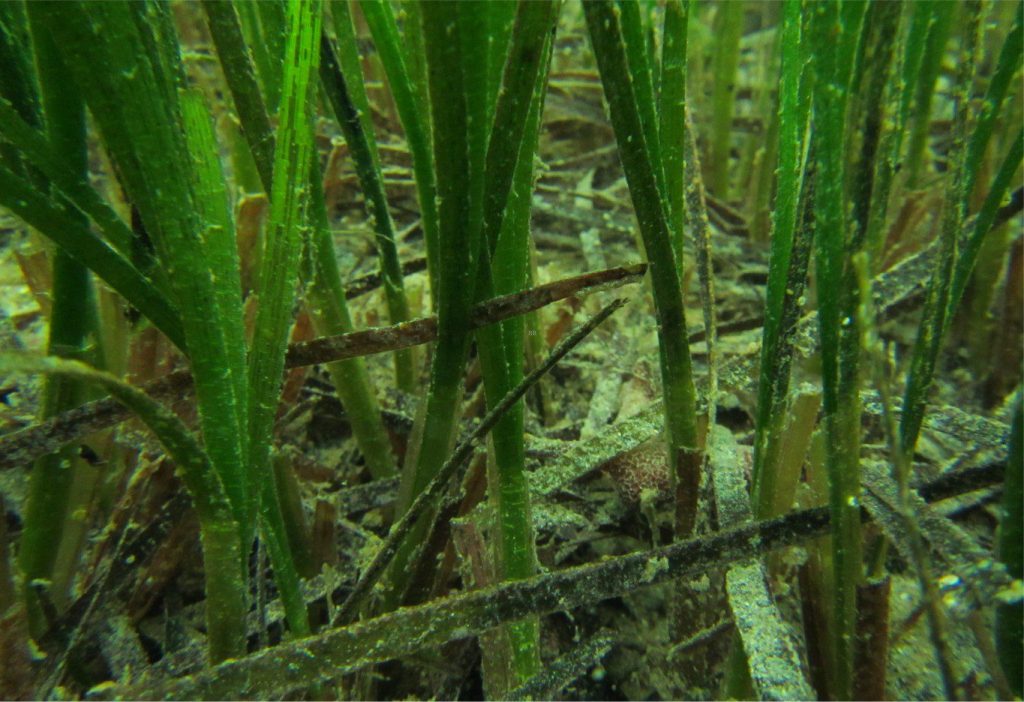
- Seagrass leaves provide a template for epifauna and epiflora (e.g., bryozoa, foraminifera, micro-algae) that become a food source for grazing fish and invertebrates such as crustaceans and gastropods.
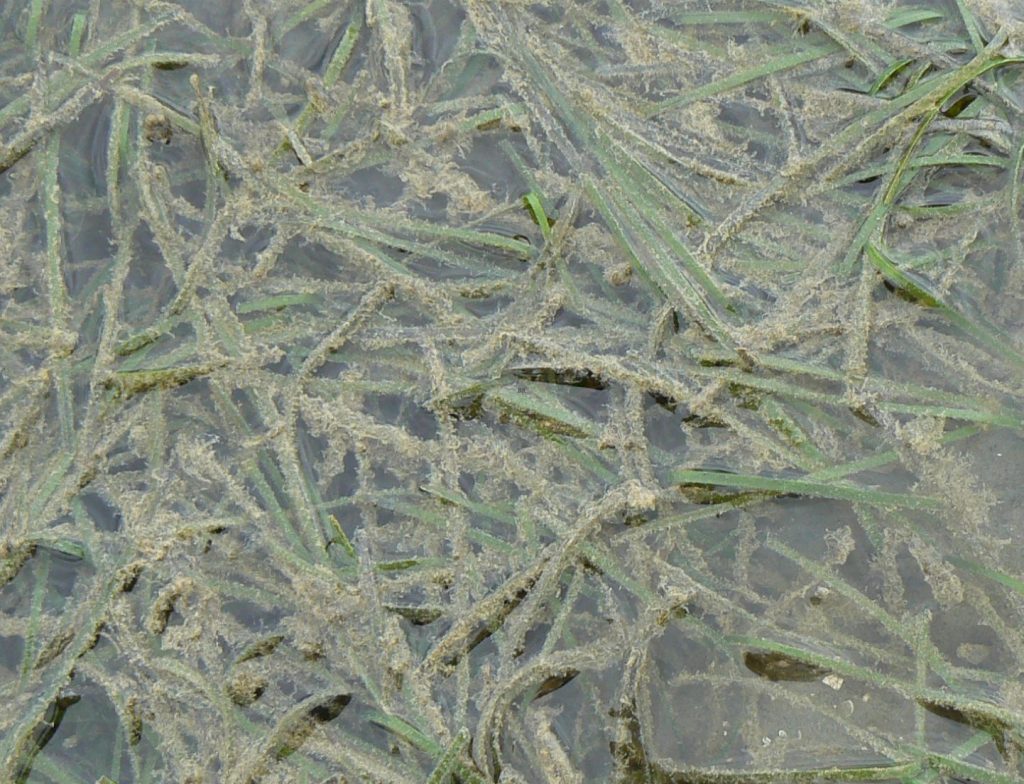
- Dense meadows provide shelter for fish, invertebrates, protozoa (e.g., foraminifera) and commonly act as nurseries for fish, crustaceans such as shrimp, and many species of mollusc, including commercially important species. These nurseries provide protection for juvenile fish, and a platform for fish and gastropod eggs. Neighbouring species groups include polychaetes (worms), echinoderms (grazers), bryozoa and sponges.
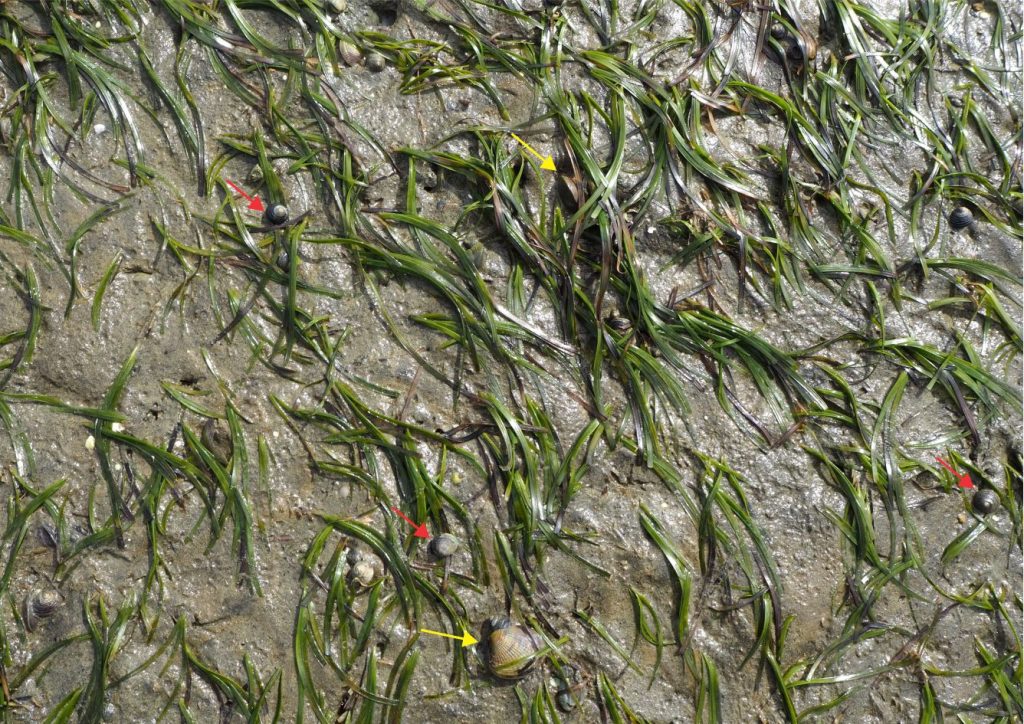
- Fish and invertebrate diversity tend to increase in areas where seagrasses thrive (similar to mangrove communities). Invertebrate diversity is also important because many species will graze macro- and microalgae that compete for the same seagrass niche.
- Seagrass leaves on tidal flats are foraged by birds and in subtidal environments by sea turtles, dugongs, and manatees.
- Seagrass communities are indicators of environmental health – acting as the ‘canary in the cage’ for eutrophication and pollution of waterways, rising seawater temperatures, and competition for their niche by invasive flora and fauna. There is a well-documented example from the 1930s when an invasive mold pathogen all but eliminated seagrass communities along most North Atlantic coasts (Short et al., op cit.). The disappearance of these communities meant that coexisting ecosystem components such as molluscs and shrimp also disappeared or moved to new neighbourhoods. Invasion of seagrass communities by non-native invertebrates from shellfish aquaculture farming has also been recorded on several British Columbia coasts (Mach et al., 2015).
Link to the companion post
Seagrass meadows and ecosystems

















